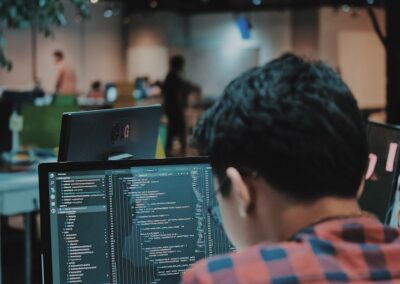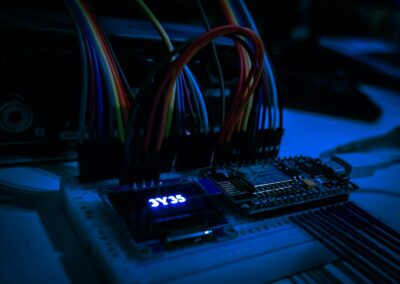Transforming Cybersecurity with AI-Driven Systems
Introduction to AI-Driven Threat Detection
In an era where cyber threats are increasingly sophisticated and pervasive, the adoption of AI-driven threat detection and response systems has become essential for enhancing cyber resilience. Business executives and mid-level managers in Saudi Arabia, the UAE, Riyadh, and Dubai must understand the significance of these advanced systems in safeguarding their organizations. AI-driven threat detection leverages the power of Artificial Intelligence to identify, analyze, and mitigate cyber threats in real-time, offering a robust defense mechanism against potential breaches.
The integration of AI in cybersecurity is not just a technological upgrade; it represents a paradigm shift in how organizations approach security. Traditional methods, while still relevant, often fall short in the face of modern, dynamic cyber threats. AI-driven systems, on the other hand, provide the agility and intelligence needed to stay ahead of malicious actors, ensuring that businesses can operate securely and efficiently.
For regions like Saudi Arabia and the UAE, where technological advancement is a key driver of economic growth, implementing AI-driven threat detection systems is crucial. These systems not only protect sensitive data and critical infrastructure but also foster a culture of security that permeates all levels of the organization.
Key Components of AI-Driven Threat Detection Systems
AI-driven threat detection systems are built on several key components that work together to provide comprehensive security coverage. The first component is machine learning algorithms. These algorithms analyze vast amounts of data to identify patterns and anomalies that may indicate a cyber threat. By continuously learning and adapting, machine learning models improve their accuracy and effectiveness over time.
The second component is real-time monitoring. AI-driven systems constantly monitor network traffic, user behavior, and system activities to detect any unusual or suspicious actions. This real-time capability allows for immediate threat identification and response, minimizing the potential impact of an attack.
The third component is automated response. When a threat is detected, AI-driven systems can automatically initiate response protocols to contain and mitigate the threat. This can include isolating affected systems, blocking malicious traffic, and alerting security teams. Automation ensures that responses are swift and precise, reducing the window of opportunity for attackers.
Benefits of AI-Driven Threat Detection Systems
The adoption of AI-driven threat detection and response systems offers numerous benefits for organizations. One of the primary advantages is enhanced accuracy. AI systems can analyze large datasets with greater precision than human analysts, reducing the likelihood of false positives and negatives. This accuracy is crucial in maintaining a robust security posture.
Another significant benefit is speed. AI-driven systems can process and analyze data in real-time, allowing for immediate threat detection and response. This rapid action is essential in preventing or minimizing the damage caused by cyberattacks. In regions like Riyadh and Dubai, where business continuity is critical, the speed of AI-driven systems is a vital asset.
Furthermore, AI-driven systems provide scalability. As organizations grow and their networks become more complex, traditional security measures may struggle to keep up. AI-driven systems, however, can scale seamlessly to accommodate increased data volumes and evolving threat landscapes. This scalability ensures that security measures remain effective regardless of the organization’s size or complexity.
Implementing AI-Driven Threat Detection in Business Operations
Case Study: A Global Technology Company’s Success
One notable example of successful implementation of AI-driven threat detection systems is a global technology company that significantly enhanced its cyber resilience. Facing a growing number of sophisticated cyber threats, the company decided to integrate AI-driven systems into its cybersecurity framework. This decision transformed its approach to threat detection and response, resulting in improved security and operational efficiency.
The company implemented machine learning algorithms to analyze network traffic and identify potential threats in real-time. These algorithms were trained on historical data, enabling them to recognize patterns associated with malicious activities. As a result, the company could detect threats that traditional methods might have missed.
Moreover, the automated response capabilities of the AI-driven system allowed the company to quickly contain and mitigate threats. By isolating affected systems and blocking malicious traffic, the company minimized the impact of cyberattacks and maintained business continuity. This proactive approach to cybersecurity not only protected the company’s assets but also instilled confidence among its stakeholders.
Best Practices for Adopting AI-Driven Threat Detection
To successfully adopt AI-driven threat detection systems, organizations should follow several best practices. The first is to ensure leadership support. Executive coaching services can help leaders understand the value of AI in cybersecurity and how to advocate for its implementation. When leadership prioritizes cybersecurity, it sets a positive tone throughout the organization.
Another best practice is to invest in continuous training and education. Employees at all levels should be aware of the capabilities and limitations of AI-driven systems. Regular training sessions can keep staff informed about the latest threats and how to respond effectively. This knowledge is crucial for maximizing the benefits of AI-driven systems.
Organizations should also prioritize data quality. The effectiveness of AI-driven threat detection relies heavily on the quality of the data being analyzed. Ensuring that data is accurate, complete, and up-to-date is essential for accurate threat detection. Regular audits and updates to data sources can help maintain high data quality standards.
The Future of AI in Cybersecurity
Looking ahead, the role of AI in cybersecurity is set to expand even further. As cyber threats continue to evolve, AI-driven systems will become increasingly sophisticated and capable. Innovations in Generative Artificial Intelligence, for example, hold the potential to create even more advanced threat detection models that can predict and preemptively respond to emerging threats.
Moreover, the integration of AI with other technologies, such as Blockchain and the Metaverse, will open new avenues for enhancing cybersecurity. Blockchain can provide immutable records of transactions, ensuring data integrity and transparency. In the context of the Metaverse, AI-driven systems can protect virtual assets and interactions, creating a secure digital environment.
For businesses in Saudi Arabia, the UAE, Riyadh, and Dubai, staying ahead of the curve in AI-driven cybersecurity is crucial for long-term success. By continuously investing in AI technologies and adopting a proactive approach to security, organizations can build resilient defenses against the ever-evolving landscape of cyber threats.
Conclusion
In conclusion, AI-driven threat detection and response systems are essential for enhancing cyber resilience in today’s digital age. By integrating advanced technologies, fostering a culture of security, and following best practices, organizations can effectively safeguard their assets and ensure business continuity. For regions like Saudi Arabia, the UAE, Riyadh, and Dubai, embracing AI-driven cybersecurity solutions is a strategic imperative for achieving sustained business success.
—
#AIDrivenSecurity #CyberResilience #CyberThreats #MiddleEastBusiness #DigitalTransformation #SaudiArabia #UAE #Riyadh #Dubai #AI #Blockchain #TheMetaverse #ExecutiveCoaching #GenerativeAI #ModernTechnology #BusinessSuccess #LeadershipSkills #ManagementSkills #ProjectManagement
























